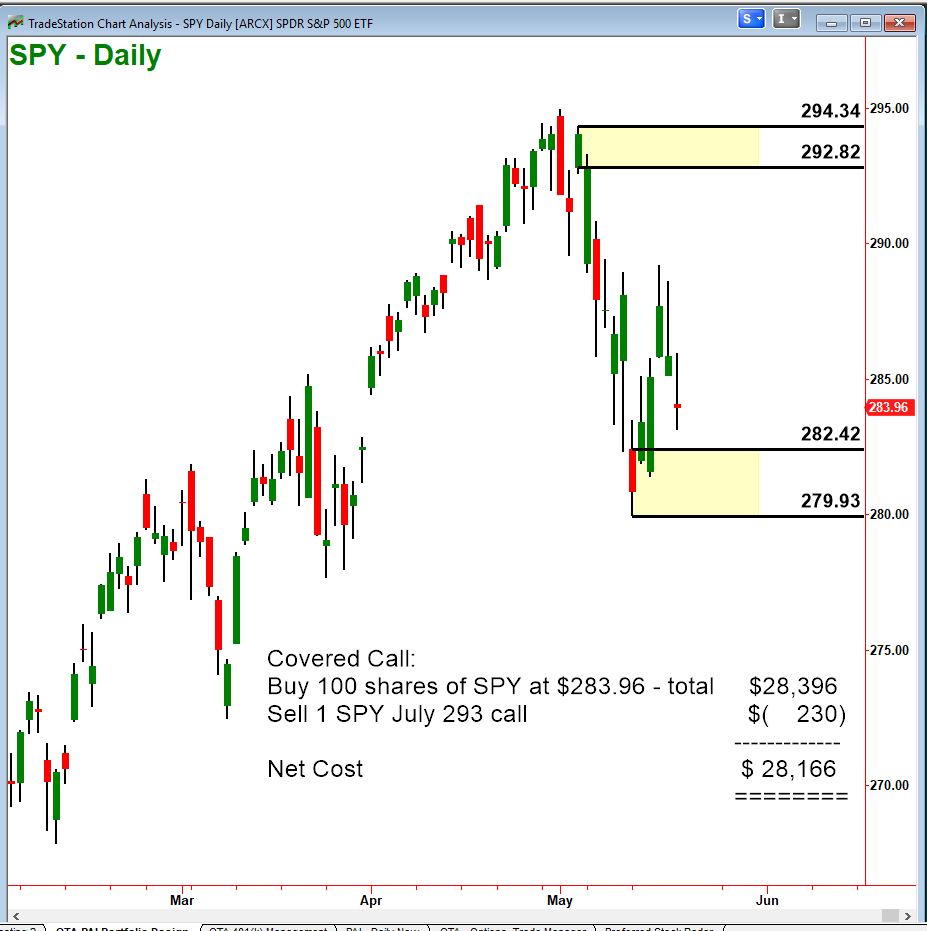Rate of Return Calculations on Simple Option Strategies for Investors
|
Today we’ll show how to calculate the potential rates of return on the Covered Call, where an investor writes (i.e. sells) calls on a stock position that they own. The cash received for the options could lower the net cost of the stock position after the fact, enhancing profits (up to a point – but more on that later).
With this strategy, we are selling options and planning to wait for them to expire. When they do expire, our profit or loss will depend on what the stock price is at the time. We can easily calculate what that profit or loss would be given specific projected stock prices.
Let’s demonstrate:
Below is a chart of SPY as of the close on May 20, 2019. Let’s say that we think that SPY will rebound from the nearby demand zone and move up in the near term to around $293. We could consider buying the SPY shares at their current price of $283.96 and simultaneously selling a call option at the $293 strike price, expiring in July. These calls could be sold for $2.30 per share, or $230 for each call option (each option is for 100 shares).
The net cost of the position would be $28,166. This would be like buying the SPY shares at $281.66 each, nicely within the yellow-shaded demand zone.
The rate of return on covered calls depends on how the stock behaves after we put the position on. If the stock goes up, we make a profit on the stock, and that profit is larger because our net cost is reduced. If the stock goes down, then we will lose money, but we will lose less than we would have had we not sold the call. Since, in this case, we sold the calls for $2.30 per share, we now have that amount of cushion. We won’t have an overall loss on the position unless SPY drops by more than $2.30 per share.
Usually the rate of return on covered calls is quoted two ways:
-
Rate of Return if Not Assigned
-
Rate of Return if Assigned
Rate of Return if Not Assigned assumes that the stock price does not move between now and the option expiration date. If we do not make or lose money on the stock during this time, then our net profit will be only what we make on the call itself. If the stock doesn’t go up, then the call will not be assigned and we will get to keep the $230 received for the call. A profit of $230 on an investment of $28,166 would be 81/100 of a percentage point in 59 days or 5.01% annualized. Not a fortune, but is it bad to make a 5% return on something that didn’t go up at all? Sounds OK to me.
The second ROR calculation, Rate of Return if Assigned, is the maximum possible profit on the position. That maximum profit is now limited. Having sold the call option, we are now obligated to turn over the stock to the call buyer when and if ordered to. We certainly will be ordered to if the stock is above $293 at expiration, so our maximum sales price can now be no more than $293. Our maximum profit would thus be our new maximum sales price for the 100 shares of $29,300, less our adjusted cost of $28,166. This is a profit of $1,134. That is 4.03% on our cost of $28,166 in a 59-day period (until the July options expire). That amounts to an annualized return of almost 25% – not bad at all!
These rate of return calculations could be summarized on a simple spreadsheet like the one below.
The calculation of the rates of return on any covered call could be done in the same way. Using a model like this, you could easily compare different covered call opportunities to find those that beat or match your investing goals.
Read the original article here - Rate of Return Calculations on Simple Option Strategies for Investors
Information on these pages contains forward-looking statements that involve risks and uncertainties. Markets and instruments profiled on this page are for informational purposes only and should not in any way come across as a recommendation to buy or sell in these assets. You should do your own thorough research before making any investment decisions. FXStreet does not in any way guarantee that this information is free from mistakes, errors, or material misstatements. It also does not guarantee that this information is of a timely nature. Investing in Open Markets involves a great deal of risk, including the loss of all or a portion of your investment, as well as emotional distress. All risks, losses and costs associated with investing, including total loss of principal, are your responsibility. The views and opinions expressed in this article are those of the authors and do not necessarily reflect the official policy or position of FXStreet nor its advertisers.
